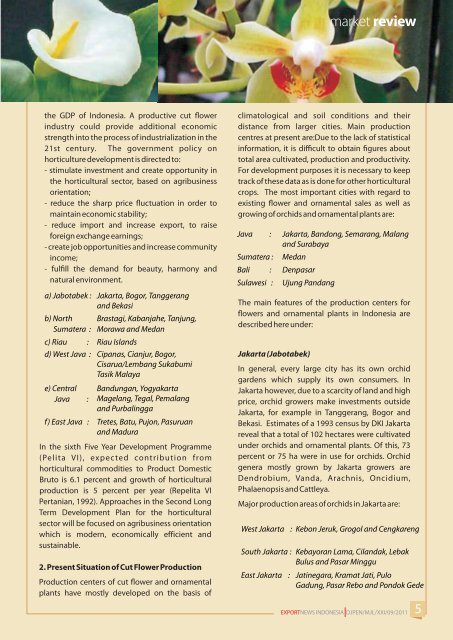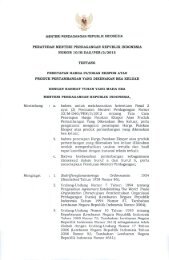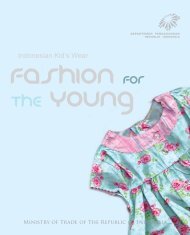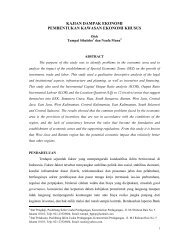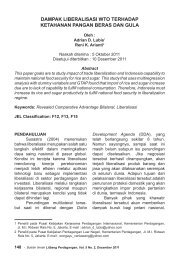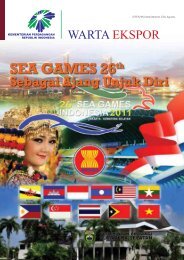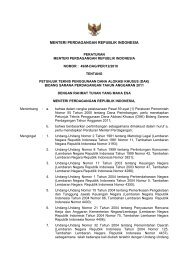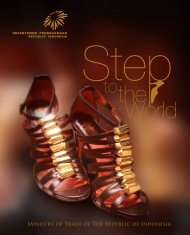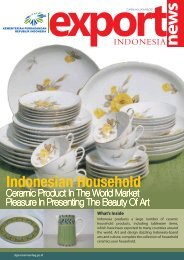Ornamental Plants - Directorate General for National Export ...
Ornamental Plants - Directorate General for National Export ...
Ornamental Plants - Directorate General for National Export ...
You also want an ePaper? Increase the reach of your titles
YUMPU automatically turns print PDFs into web optimized ePapers that Google loves.
market review<br />
the GDP of Indonesia. A productive cut flower<br />
industry could provide additional economic<br />
strength into the process of industrialization in the<br />
21st century. The government policy on<br />
horticulture development is directed to:<br />
- stimulate investment and create opportunity in<br />
the horticultural sector, based on agribusiness<br />
orientation;<br />
- reduce the sharp price fluctuation in order to<br />
maintain economic stability;<br />
- reduce import and increase export, to raise<br />
<strong>for</strong>eign exchange earnings;<br />
- create job opportunities and increase community<br />
income;<br />
- fulfill the demand <strong>for</strong> beauty, harmony and<br />
natural environment.<br />
a) Jabotabek : Jakarta, Bogor, Tanggerang<br />
and Bekasi<br />
b) North<br />
Sumatera :<br />
c) Riau : Riau Islands<br />
Brastagi, Kabanjahe, Tanjung,<br />
Morawa and Medan<br />
d) West Java : Cipanas, Cianjur, Bogor,<br />
Cisarua/Lembang Sukabumi<br />
Tasik Malaya<br />
e) Central<br />
Java :<br />
Bandungan, Yogyakarta<br />
Magelang, Tegal, Pemalang<br />
and Purbalingga<br />
f) East Java : Tretes, Batu, Pujon, Pasuruan<br />
and Madura<br />
In the sixth Five Year Development Programme<br />
(Pelita VI), expected contribution from<br />
horticultural commodities to Product Domestic<br />
Bruto is 6.1 percent and growth of horticultural<br />
production is 5 percent per year (Repelita VI<br />
Pertanian, 1992). Approaches in the Second Long<br />
Term Development Plan <strong>for</strong> the horticultural<br />
sector will be focused on agribusiness orientation<br />
which is modern, economically efficient and<br />
sustainable.<br />
2. Present Situation of Cut Flower Production<br />
Production centers of cut flower and ornamental<br />
plants have mostly developed on the basis of<br />
climatological and soil conditions and their<br />
distance from larger cities. Main production<br />
centres at present are:Due to the lack of statistical<br />
in<strong>for</strong>mation, it is difficult to obtain figures about<br />
total area cultivated, production and productivity.<br />
For development purposes it is necessary to keep<br />
track of these data as is done <strong>for</strong> other horticultural<br />
crops. The most important cities with regard to<br />
existing flower and ornamental sales as well as<br />
growing of orchids and ornamental plants are:<br />
Java : Jakarta, Bandong, Semarang, Malang<br />
and Surabaya<br />
Sumatera :<br />
Medan<br />
Bali : Denpasar<br />
Sulawesi :<br />
West Jakarta<br />
Ujung Pandang<br />
The main features of the production centers <strong>for</strong><br />
flowers and ornamental plants in Indonesia are<br />
described here under:<br />
Jakarta (Jabotabek)<br />
In general, every large city has its own orchid<br />
gardens which supply its own consumers. In<br />
Jakarta however, due to a scarcity of land and high<br />
price, orchid growers make investments outside<br />
Jakarta, <strong>for</strong> example in Tanggerang, Bogor and<br />
Bekasi. Estimates of a 1993 census by DKI Jakarta<br />
reveal that a total of 102 hectares were cultivated<br />
under orchids and ornamental plants. Of this, 73<br />
percent or 75 ha were in use <strong>for</strong> orchids. Orchid<br />
genera mostly grown by Jakarta growers are<br />
Dendrobium, Vanda, Arachnis, Oncidium,<br />
Phalaenopsis and Cattleya.<br />
Major production areas of orchids in Jakarta are:<br />
: Kebon Jeruk, Grogol and Cengkareng<br />
South Jakarta : Kebayoran Lama, Cilandak, Lebak<br />
Bulus and Pasar Minggu<br />
East Jakarta : Jatinegara, Kramat Jati, Pulo<br />
Gadung, Pasar Rebo and Pondok Gede<br />
EXPORTNEWS INDONESIA DJPEN/MJL/XXI/09/2011 5


